Intellectual property law is how you capture and protect the Creativity in your business.
This free legal information is made available courtesy of Counsel to Creativity.
When I talk about your business’s Creativity this is what I mean: What you offer and put out into the world that is uniquely your business.
There are three main types of intellectual property law—copyright, trademark and patent. Each covers a different type of creativity or innovation.
Copyright protects your original work (the expression of your idea in a form, like a blog or a photograph).
Trademark protects how you identify your business as the source of its goods or services in the market.
Patent protects a new and useful process, machine, product, composition of matter or plant variety.
What is Intellectual Property and how does it work?
Understanding what intellectual property actually is and how it works is important to you understanding what pieces of intellectual property you’ve got and how they can work for your business.
Intellectual Property is how your original ideas are expressed. It’s not the ideas themselves.
Ideas are left for all of us to use and build upon to create new ideas and new expressions of those ideas. Ideas build upon each other, and we value that as a society. So law leaves ideas for all of us to use.
Intellectual Property is property that results from original thought, and legally, property has certain characteristics.
What I think is so beautiful about property it is that it’s so flexible. You can do just about what you want with it to create and trade value. What people and businesses can do, and want to do, with property can be as creative as the original work itself. That excites me. (And let’s face it, people making a life and a business off their creativity and originality excites me.)
The reason there is so much flexibility in intellectual property is because of the nature of property itself. Legally, property is not one solid, single object to sell or buy or give away. Property is actually made up of pieces—rights.
 You can think of intellectual property as a jar of markers.
You can think of intellectual property as a jar of markers.
Ownership of intellectual property (in the form of a copyright, a trademark or a patent) means holding the jar itself and all the markers in the jar. The jar is the container of ownership—the copyright, trademark or patent—and the markers are each of the specific rights to the property. You can offer the markers (rights) individually or in groups to any other person or business for any purpose for which you would like to make the intellectual property available.
To make it familiar and tangible, consider a house. You can own a house and give someone else the right to live in the house by renting it. You still own the house; you still have the right to sell or to rent the house. But your tenant has the right to occupy the house. There are other rights to your house that we could name, but you get the picture. Trademarks, copyrights and patents work the same way.
In the comments, let me know what one aha! you had about copyrights and trademarks. I’d love to hear.
Did this help you? Like it or tweet it and help another creative entrepreneur!
Identify what you need to know about law for your business with my Free Mind Map.
![]() Looking to change your business to better suit your life? Rebecca Prien also provides business coaching and business model design services through Ompreneur | The Yoga of Entrepreneurship.
Looking to change your business to better suit your life? Rebecca Prien also provides business coaching and business model design services through Ompreneur | The Yoga of Entrepreneurship.

